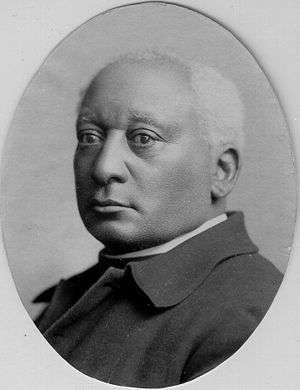Benjamin W. Arnett

Benjamin W. Arnett (1838–1906) was an African-American educator, minister, bishop and elected official. He was born a free man in 1838 in Brownsville, Pennsylvania, where he taught school from 1859 to 1867. In his youth, Arnett lost a leg to an infection suffered after an ankle injury while working on a steam boat between 1857-58.[1]
As a pastor in the African Methodist Episcopal Church (AME), Arnett served parishes in Toledo, Cincinnati, and Columbus;[2] under his leadership, St. Paul's Church in Urbana was completed. It has been designated as a historical landmark.[3] In 1888, he was elected bishop, a position he held until his death in 1906.
In 1872 Arnett became the first black man to serve as foreman of an otherwise all-white jury. In 1885, he was elected to the Ohio General Assembly from a district with an 85 percent white majority, thus becoming the first African-American to represent a predominantly white constituency.[4] That same year another African-American, Jeremiah A. Brown, was elected from Cleveland, and the two frequently worked together.[5] In 1886, as Republican representative from Greene County in the Ohio General Assembly, Arnett introduced legislation to repeal the state's "Black Laws,” which limited the freedom and rights of African-American residents. Arnett was particularly concerned that state law did not ensure that black children had the same educational opportunities as white children. In 1887, statues regarding education were changed; the state was thereafter required to provide equal opportunities to all children regardless of race. A forceful and compelling speaker, Arnett was influential in Republican politics, thanks, in part, to his friendship with fellow legislator (and later president), William McKinley.[4]
Bishop Arnett's influence is felt in the Pentecostal community. His great-grandson, Right Reverend Benjamin Terwood Douglass of Cleveland, Ohio, is the Seventh Bishop elevated in the Pentecostal Churches of Christ. Bishop Douglass serves as Secretary-General of that Reformation which has its roots in Methodism.
References
- ↑ Builders of Ohio edited by Warren Van Tine & Michael Pierce Ohio State Press 2003
- ↑ African Methodist Episcopal Church, Ohio Historical Society, 2005-07-01. Accessed 2010-06-10.
- ↑ Ogden, John W. The History of Champaign County, Ohio. Chicago: Beers, 1881, 363.
- 1 2 Official Discipline, Pentecostal Churches of Christ, Cleveland, Ohio 2009
- ↑ Simmons, William J., and Henry McNeal Turner. Men of Mark: Eminent, Progressive and Rising. GM Rewell & Company, 1887. p113-117